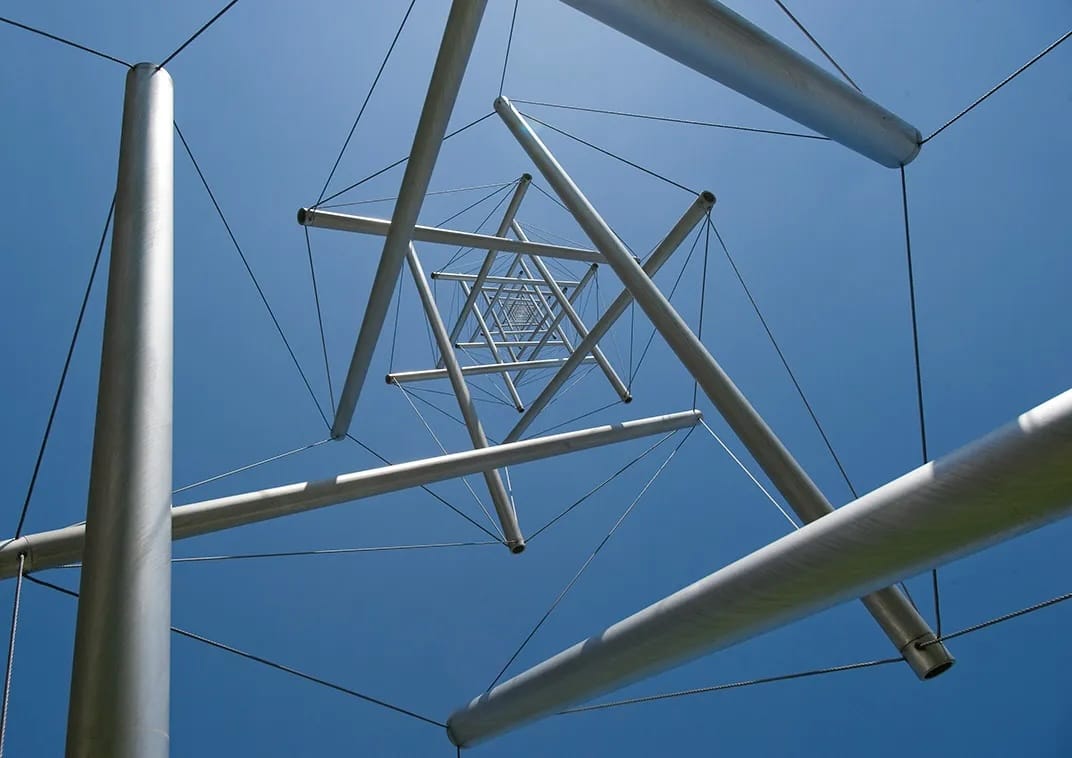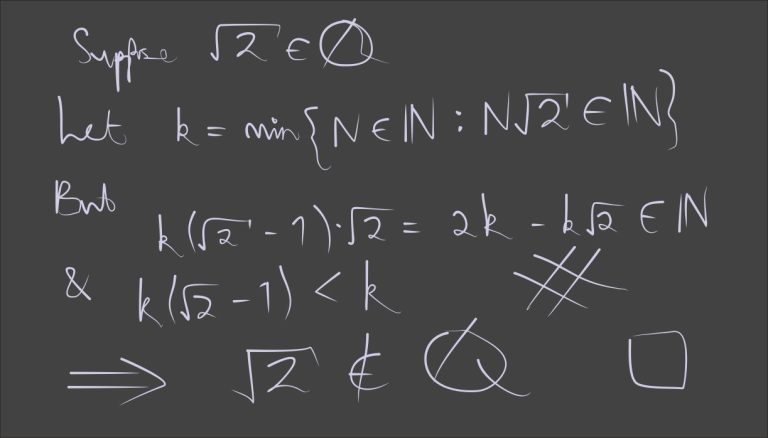Needle Tower isn’t just a sculpture—it’s an optical puzzle, a question posed in steel and cable. Imagine this: in front of you stands a tower as tall as a six-story building, made of metal rods and cables. But it’s a tower like no other—its parts don’t even touch. This structure, with components floating in space, stands tall only thanks to tension (yes, literal tension like a tightly drawn string). Even more incredible, it touches the ground at a single point no larger than 14 inches—and yet it stands strong even through storms.
Behold: Needle Tower—a 60-foot sculpture by Kenneth Snelson, erected in 1968 and now rising over the sculpture garden of the Hirshhorn Museum in Washington, D.C. But this isn’t just a work of art; it’s a bold statement where art and engineering fuse into one.
“How Does This Stand?”—A Question That Turns Into Wonder
Anyone seeing the Needle Tower for the first time asks the same thing: “How does something so tall stand upright with barely any contact with the ground?” The answer lies somewhere between physics and philosophy.

The structure is based on a design principle called tensegrity, short for “tensional integrity.” Coined by Buckminster Fuller but physically realized by Snelson, the term refers to structures that rely on continuous tension and discontinuous compression to stay upright.
Here’s how it works: aluminum rods act as compression components. They don’t touch each other at all. Instead, they are suspended in place by stainless steel cables. The cables keep the rods in place by pulling; the rods keep the cables taut by pushing back. It’s a perfect dance of opposing forces, a living application of Newton’s third law.
From Space to Sculpture
Snelson was inspired by nature itself when making this tower. Think about spider webs, bicycle wheels, or a kite pulled taut by its string. All of these systems distribute force through tension. Snelson once said, “My works are abstractions of the structural beauty found in nature.” And it shows.
In fact, if you stand inside Needle Tower and look up, you’ll see an astonishing view: a geometric spiral of six-pointed stars stretching into the sky. It’s not symbolic—just pure geometry. Each level of the tower consists of three rods arranged helically, alternating in left and right-handed patterns. When aligned vertically, they naturally form six-pointed stars.

This elegant intersection of nature, geometry, and engineering reminds us how early exposure to such ideas can spark lifelong curiosity. If you’re raising a young mind who’s fascinated by how the world fits together—from spiderwebs to steel towers—take a look at our 50 Best STEM Books for Kids Who Love Science, Technology, Engineering, and Math. These books open up the same kinds of wonder that Needle Tower evokes in grown-ups.
Physics, Aesthetics, and a Dash of Madness
What gives Needle Tower its artistic power is not just its engineering, but the emotion it evokes. As curator Valerie Fletcher says, “It makes us look up. It connects us with the cosmos. And that, to me, is uplifting”.
Walking beneath the sculpture and looking up is almost a mystical experience. The repeating pattern of stars ascending into the sky feels like a staircase to infinity. The artwork stops being an object you look at and becomes something that draws you in.
How Needle Tower Survives Storms and Time?
Initially, Needle Tower required no maintenance. It stood firm through storms and harsh weather. But over time, the thinner wires started to fray. In 2010, the Hirshhorn Museum undertook a full restoration of the piece. Kenneth Snelson himself supervised the work and replaced the top segment. It took a 15-person team to carefully raise the sculpture back into place.
You can actually watch this fascinating process in the short video of the installation of Kenneth Snelson’s “Needle Tower” on YouTube. Seeing the structure being delicately lifted and reassembled is a masterclass in precision, teamwork, and reverence for engineering-based art.
Even today, during hurricane warnings, the museum gently lays the tower down on its side. Though it’s structurally strong, the tower is flexible and sways in the wind. It’s alive in its own way.
Reading the Sculpture Like a Message
Snelson may have denied any symbolic intent, but viewers can’t help seeing deeper meaning in Needle Tower. Some see it as a metaphor for coexistence with nature rather than domination over it. Others see a bridge between engineering and aesthetics. Some see it as a conversation between strength and elegance.
The simplicity of the design is deceptive. At first glance, it looks like nothing more than suspended metal rods. But a closer look reveals incredible complexity, balance, and design woven into every joint.
Art or Engineering?

Some structures belong in art galleries, others in engineering labs. Needle Tower stands between the two. It’s not just a technical model, nor simply an abstract sculpture. That’s why it captivates both art historians and physicists.
Snelson didn’t just build something beautiful. He questioned the boundaries of form and function. The tensegrity concept has since found applications in fields ranging from robotics to architecture—even NASA has explored tensegrity structures for Mars missions. Imagine that: a sculpture in Washington helping shape machines for another planet.
And if the fusion of engineering and art intrigues you as much as it did Snelson, then The Art of Doing Science and Engineering: Learning to Learn by Richard W. Hamming might be your next favorite read. It’s an exceptional book about thinking, building, and discovering—perfect for anyone fascinated by how structured ideas turn into beautiful realities.
Final Thoughts: A Lesson in Balance That Looks Upward
Needle Tower isn’t just a pile of metal. It’s a question posed to the sky: “What does it mean to be in balance?” It challenges the idea that stability comes only from being firmly grounded. And then it answers: No. Sometimes, to stand tall, all you need is the right tension in the right places.
If you ever find yourself in Washington, D.C., go to the Hirshhorn Museum. Walk beneath the Needle Tower. Look up. In that moment, you’ll understand everything I’ve tried to say here—deep in your bones.






